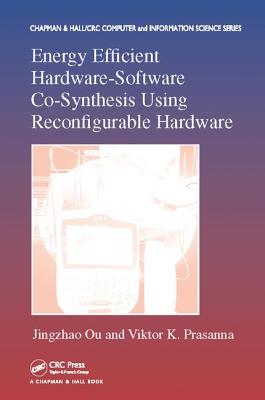Low-Power Design of Nanometer FPGAs: Architecture and EDA (Hardcover)
暫譯: 奈米級 FPGA 的低功耗設計:架構與 EDA (精裝版)
Hassan Hassan, Mohab Anis
- 出版商: Morgan Kaufmann
- 出版日期: 2009-10-01
- 售價: $1,150
- 貴賓價: 9.8 折 $1,127
- 語言: 英文
- 頁數: 256
- 裝訂: Hardcover
- ISBN: 0123744385
- ISBN-13: 9780123744388
-
相關分類:
FPGA
下單後立即進貨 (約5~7天)
買這商品的人也買了...
-
 大話設計模式
大話設計模式$620$490 -
 企業資源規劃-系統演練與實務應用
企業資源規劃-系統演練與實務應用$580$522 -
 Windows Device Driver Programming 驅動程式設計
Windows Device Driver Programming 驅動程式設計$650$507 -
 JavaScript: The Definitive Guide: Activate Your Web Pages, 6/e (Paperback)
JavaScript: The Definitive Guide: Activate Your Web Pages, 6/e (Paperback)$2,400$2,280 -
 大話資料結構
大話資料結構$590$466 -
 $438101 Spy Gadgets for the Evil Genius, 2/e (Paperback)
$438101 Spy Gadgets for the Evil Genius, 2/e (Paperback) -
 網路機器人、網路蜘蛛與網路爬蟲-PHP/CURL 程式設計指南, 2/e (Webbots, Spiders, and Screen Scrapers: A Guide to Developing Internet Agents with PHP/CURL, 2/e)
網路機器人、網路蜘蛛與網路爬蟲-PHP/CURL 程式設計指南, 2/e (Webbots, Spiders, and Screen Scrapers: A Guide to Developing Internet Agents with PHP/CURL, 2/e)$550$435 -
 計算機概論─探索未來, 8/e
計算機概論─探索未來, 8/e$650$507 -
 Canon EOS 700D 活用超入門
Canon EOS 700D 活用超入門$320$272 -
 $1,496Programming 3D Applications with HTML5 and WebGL: 3D Animation and Visualization for Web Pages (Paperback)
$1,496Programming 3D Applications with HTML5 and WebGL: 3D Animation and Visualization for Web Pages (Paperback) -
 紅外線發射感測器
紅外線發射感測器$50$48 -
 菲絲恩教你學會 Python
菲絲恩教你學會 Python$300$234 -
 $594AngularJS 權威教程
$594AngularJS 權威教程 -
 HTML5: The Missing Manual, 2/e (國際中文版)
HTML5: The Missing Manual, 2/e (國際中文版)$580$458 -
 與成功有約 (25週年增修版)
與成功有約 (25週年增修版)$380$323 -
 Python 程式設計入門 (適用於 2.x 與 3.x 版)
Python 程式設計入門 (適用於 2.x 與 3.x 版)$620$484 -
 $354Hadoop YARN權威指南
$354Hadoop YARN權威指南 -
 Arduino 自作專案大百科 (Arduino Project Handbook)
Arduino 自作專案大百科 (Arduino Project Handbook)$380$300 -
 當猛虎遇上Android | 一手掌握Android App程式開發與設計
當猛虎遇上Android | 一手掌握Android App程式開發與設計$880$695 -
 OpenCV with Microsoft Visual Studio 影像辨識處理
OpenCV with Microsoft Visual Studio 影像辨識處理$580$452 -
 R 軟體資料分析基礎與應用 (R for Everyone: Advanced Analytics and Graphics)
R 軟體資料分析基礎與應用 (R for Everyone: Advanced Analytics and Graphics)$650$553 -
 Mazes for Programmers: Code Your Own Twisty Little Passages (Paperback)
Mazes for Programmers: Code Your Own Twisty Little Passages (Paperback)$1,430$1,359 -
.jpg) 統計學,最強的商業武器:實踐篇
統計學,最強的商業武器:實踐篇$380$300 -
 大話重構
大話重構$390$304 -
 用 Kali Linux 破解每一台連網裝置
用 Kali Linux 破解每一台連網裝置$580$493
相關主題
商品描述
<內容簡介>
Low-Power Design of Nanometer FPGAs Architecture and EDA is an invaluable reference for researchers and practicing engineers concerned with power-efficient, FPGA design. State-of-the-art power reduction techniques for FPGAs will be described and compared. These techniques can be applied at the circuit, architecture, and electronic design automation levels to describe both the dynamic and leakage power sources and enable strategies for codesign.
<章節目錄>
Chapter 1: FPGA Overview: Architecture and CAD
1.1 Introduction
1.2 FPGA Logic Resources Architecture
1.3 FPGA Routing Resources Architecture
1.4 CAD for FPGAs
1.5 Versatile Place and Route (VPR) CAD Tool
Chapter 2: Power Dissipation in Modern FPGAs
2.1 CMOS Technology Scaling Trends and Power Dissipation in VLSI Circuits
2.2 Dynamic Power in FPGAs
2.3 Leakage Power in FPGAs
Chapter 3: Power Estimation in FPGAs
3.1 Introduction
3.2 Power Estimation in VLSI: An Overview
3.3 Commercial FPGA Power Estimation Techniques
3.4 A Survey of FPGA Power Estimation Techniques
3.5 A Complete Analytical FPGA Power Model under Spatial Correlation
Chapter 4: Dynamic Power Reduction Techniques in FPGAs
4.1 Multiple Supply Voltages
4.2 Reducing Glitches in FPGAs
4.3 CAD Techniques for Reducing Dynamic Power in FPGAs
Chapter 5: Leakage Power Reduction in FPGAs Using MTCMOS Techniques
5.1 Introduction
5.2 MTCMOS FPGA Architecture
5.3 Sleep Transistor Design and Discharge Current Processing
5.4 Activity Profile Generation
5.5 Activity Packing Algorithms
5.6 Power Estimation
5.7 Results an Discussion
Chapter 6: Leakage Power Reduction in FPGAs Through Input Pin Reordering
6.1 Leakage Power and Input State Dependency in FPGAs
6.2 Proposed Input Pin Reordering Algorithm
6.3 Experimental Results
6.4 Conclusion
商品描述(中文翻譯)
內容簡介
《奈米級FPGA架構與EDA的低功耗設計》是一本對於關心功率效率的FPGA設計的研究人員和實務工程師來說,極具價值的參考書。書中將描述並比較最先進的FPGA功率降低技術。這些技術可以應用於電路、架構和電子設計自動化層面,以描述動態和漏電功率來源,並啟用共同設計的策略。
章節目錄
第1章:FPGA概述:架構與CAD
1.1 介紹
1.2 FPGA邏輯資源架構
1.3 FPGA路由資源架構
1.4 FPGA的CAD
1.5 多功能放置與路由(VPR)CAD工具
第2章:現代FPGA中的功率耗散
2.1 CMOS技術縮放趨勢與VLSI電路中的功率耗散
2.2 FPGA中的動態功率
2.3 FPGA中的漏電功率
第3章:FPGA中的功率估算
3.1 介紹
3.2 VLSI中的功率估算:概述
3.3 商業FPGA功率估算技術
3.4 FPGA功率估算技術調查
3.5 考慮空間相關性的完整分析FPGA功率模型
第4章:FPGA中的動態功率降低技術
4.1 多個供電電壓
4.2 減少FPGA中的毛刺
4.3 降低FPGA動態功率的CAD技術
第5章:使用MTCMOS技術降低FPGA中的漏電功率
5.1 介紹
5.2 MTCMOS FPGA架構
5.3 睡眠晶體管設計與放電電流處理
5.4 活動輪廓生成
5.5 活動打包演算法
5.6 功率估算
5.7 結果與討論
第6章:通過輸入引腳重新排序降低FPGA中的漏電功率
6.1 FPGA中的漏電功率與輸入狀態依賴性
6.2 提出的輸入引腳重新排序演算法
6.3 實驗結果
6.4 結論































